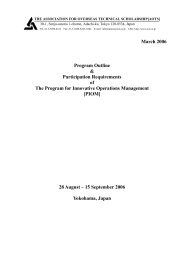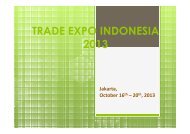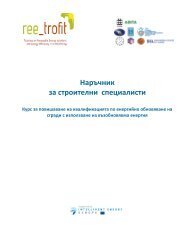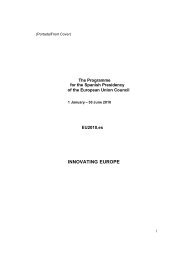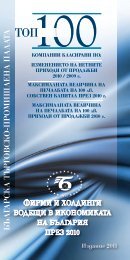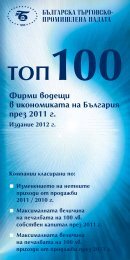<strong>Analysis</strong> <strong>of</strong> <strong>the</strong> <strong>Operation</strong> <strong>and</strong> <strong>Financial</strong> <strong>Condition</strong> <strong>of</strong> <strong>the</strong> <strong>Enterprise</strong>year after <strong>the</strong> expiry <strong>of</strong> <strong>the</strong> term, it is possible to exclude <strong>the</strong>se 40,000 CU from <strong>the</strong> currentdebts as <strong>the</strong>y are not due in <strong>the</strong> short-term, <strong>and</strong> <strong>the</strong>refore <strong>the</strong> real amount <strong>of</strong> current debtsdue in a short time to <strong>the</strong> creditors is by 40,000 CU less. This could improve <strong>the</strong> overallliquidity measures to some extent. Therefore, in Table 5.2 <strong>the</strong>re is a new overall liquidityvalue arrived at with <strong>the</strong> 40,000 CU being deducted from <strong>the</strong> amount <strong>of</strong> short-term debts.In calculation <strong>of</strong> <strong>the</strong> quick ratio <strong>the</strong> 40,000 CU will also be deducted from <strong>the</strong> amount <strong>of</strong>current debts.Table 5.2Adjusted estimate <strong>of</strong> <strong>the</strong> <strong>Enterprise</strong> N overall liquidity for <strong>the</strong> period from31/12/2XX7 to 31/12/2XX9 (in CU)Dec.,2XX7March,2XX8June,2XX8Sept.,2XX8Dec.,2XX8March,2XX9June,2XX9Sept.,2XX9After reducing <strong>the</strong> amount <strong>of</strong> short-term debt by <strong>the</strong> credit line <strong>of</strong> 40,000 CU <strong>the</strong>overall liquidity is slightly improved (see Table 5.2). Now liquidity is almost always above<strong>the</strong> critical level <strong>of</strong> 1 by <strong>the</strong> end <strong>of</strong> March, 2XX9, while afterwards it is below <strong>the</strong> criticallevel <strong>of</strong> 1. Theoretically, this enterprise should have undergone <strong>the</strong> bankruptcy procedurein <strong>the</strong> middle <strong>of</strong> year 2XX9 already, however, in view <strong>of</strong> <strong>the</strong> fact that this enterprise isoperating in <strong>the</strong> construction industry where suppliers await <strong>the</strong>ir invoices to be paid forone year even, <strong>the</strong> enterprise is still in business. If <strong>the</strong> debt to suppliers is too high <strong>and</strong> hasnot been paid for a considerable amount <strong>of</strong> time, <strong>the</strong> suppliers cease supplying materials to<strong>the</strong> enterprise until <strong>the</strong>y receive at least a partial payment for <strong>the</strong> debt. There areconstruction materials stores that have set <strong>the</strong> maximum credit limit which can be reachedwithout having to face any sanctions. As it was noted before <strong>the</strong> largest materials supplierhad issued <strong>the</strong> maximum debt or credit limit <strong>of</strong> 40,000 CU to <strong>Enterprise</strong> N, because inconsideration <strong>of</strong> <strong>the</strong> amount <strong>of</strong> construction materials purchased by <strong>Enterprise</strong> N from <strong>the</strong>largest materials supplier, this is beneficial for <strong>the</strong> creditor.Quick liquidity ratioIn <strong>the</strong> estimation <strong>of</strong> this measure <strong>the</strong> formula for calculation <strong>of</strong> <strong>the</strong> quick ratio 4.2or 4.3 is applied. In order to calculate <strong>the</strong> quick ratio, it is necessary to know <strong>the</strong> totalamount <strong>of</strong> company’s current assets, stock, prepaid expenses <strong>and</strong> <strong>the</strong> amount <strong>of</strong> short-termdebts.Table 5.3Estimate <strong>of</strong> <strong>the</strong> <strong>Enterprise</strong> N quick liquidity ratio for <strong>the</strong> period from31/12/2XX7 to 31/12/2XX9 (in CU)Dec.,2XX9Totalcurrentassets 167806 210557 241778 343779 318301 476754 386462 296149 304415Adjustedshort-termdebts 152 442 177 224 275 697 256 244 287 454 430 252 505 623 437 655 378 595Overallliquidity 1,10 1,19 0,88 1,34 1,11 1,11 0,76 0,68 0,80Dec., March, June, Sept., Dec., March, June, Sept., Dec.,94
<strong>Analysis</strong> <strong>of</strong> <strong>the</strong> <strong>Operation</strong> <strong>and</strong> <strong>Financial</strong> <strong>Condition</strong> <strong>of</strong> <strong>the</strong> <strong>Enterprise</strong>2XX7 2XX8 2XX8 2XX8 2XX8 2XX9 2XX9 2XX9 2XX9Total currentassets 167806 210557 241778 343779 318301 476754 386462 296149 304415Stock 203 347 1491 653 1036 666 3057 4416 1005Prepaidexpenses 1761 1869 1932 2228 2479 2743 3016 3686 2866Adjustedshort-termdebts 152442 177224 275697 256244 287454 430252 505623 437655 378595Quickliquidityratio 1,09 1,18 0,86 1,33 1,10 1,10 0,75 0,66 0,79By looking at Table 5.3, where <strong>the</strong> dynamics <strong>of</strong> <strong>the</strong> quick ratio values are displayedfor <strong>the</strong> period between 31/12/2XX7 <strong>and</strong> 13/12/2XX9 <strong>and</strong> comparing it with <strong>the</strong> overallliquidity dynamics shown in Table 5.2, it is clear that <strong>the</strong> overall liquidity is almost as highas <strong>the</strong> quick ratio as <strong>the</strong> amount <strong>of</strong> stock <strong>and</strong> prepaid expenses from total assets isinsignificant. It can be said that <strong>the</strong> total assets <strong>of</strong> <strong>the</strong> enterprise are liquid assets, because<strong>the</strong> quick ratio is <strong>the</strong> relationship <strong>of</strong> liquid assets <strong>and</strong> <strong>the</strong> short-term liabilities. Of course, itis a general statement, as any judgement concerning <strong>the</strong> real level <strong>of</strong> liquidity can be madeonly upon <strong>the</strong> analysis <strong>of</strong> accounts receivable, because <strong>the</strong>re is a possibility that bad debtsconstitute a large percentage <strong>of</strong> accounts receivable. Accounts receivable will be analysedlater.The analysis carried out allows to draw <strong>the</strong> conclusion that both <strong>the</strong> overallliquidity <strong>and</strong> <strong>the</strong> quick ratio <strong>of</strong> <strong>the</strong> enterprise has been too low starting with March, 2XX9,which means that <strong>the</strong> enterprise is facing problems with paying <strong>of</strong>f <strong>the</strong>ir creditors’ debts.Ano<strong>the</strong>r important measure <strong>of</strong> assessment <strong>of</strong> <strong>the</strong> liquidity status is <strong>the</strong> currentcapital or working capital, which is estimated as <strong>the</strong> difference between <strong>the</strong> amount <strong>of</strong>current assets <strong>and</strong> short-term debts (see 4.6. formula 4.6) As it has been stated before <strong>the</strong>short-term debts were adjusted by 40,000 CU in <strong>the</strong> amount <strong>of</strong> <strong>the</strong> credit line issued. Theamount <strong>of</strong> current capital or working capital is calculated in Table 5.4.Table 5.4Estimation <strong>of</strong> <strong>the</strong> working capital for <strong>the</strong> period from 31/12/2XX7 to31/12/2XX9 (in CU)Dec.,2XX7March, 2XX8June,2XX8Sept.,2XX8Dec.,2XX8March, 2XX9June,2XX9Sept.,2XX9Dec.,2XX9Workingcapital 167806 210557 241778 343779 318301 476754 386462 296149 304415Adjustedshort-termdebts 152442 177224 275697 256244 287454 430252 505623 437655 378595Workingcapital 15364 33333 -33919 87535 30847 46502 -119161 -141506 -74180Changes inworking - 17969 -67252 121454 -56688 15655 -165663 -22345 6732695



